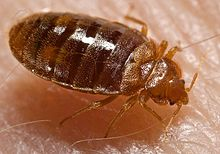Bed bugs are small wingless insects that feed on the blood of warm blooded-animals. As humans, we are ideal hosts for bed bugs which so called because of their preferred habitat in human homes: sofas, bed mattresses, etc. Most bed bugs feed on their hosts while they are asleep.
These insects feed exclusively on blood and may survive a year without eating. They are attracted by body warmth and carbon dioxide. Transfer to new places is usually in the personal effects of the human they feed upon.
Bugs and eggs inadvertently brought in from other infested dwellings on a visiting person’s clothing or luggage
Infested items (such as furniture, clothing, or backpacks) brought in;
Nearby dwellings or infested items, if easy routes are available for travel, e.g. through ducts or false ceilings
Though bed bugs will feed on pets, they do not live or travel on the skin of their hosts, and pets are not believed to be a factor in their spread
Bed bugs require blood in order to reproduce and complete their life cycle. The effect of bed bug bites varies among people, but they eventually produce red welts that itch. The bites themselves are not painful and typically are not felt. However, frequent feeding can disrupt people’s sleep and make them irritable, and seeing bites may cause emotional.
QUALITY ASSURANCE TIP
Always ask your pest control provider to provide an integrated pest management (IPM) plan for your
HEALTH & SAFETY TIP
Infested (but intact) mattresses, upholstery and items that cannot be washed with hot water. Bedbugs die at 50°C
ENVIRONMENTAL TIP
“You may need professional services and pesticides, but perhaps try these more environmentally friendly ideas seems that bed bugs can be killed with temperatures above 60 degrees Celsius (140 degrees Fahrenheit) so steam cleaning carpet, furniture.
CALL DAG & BRAGAN LTD FOR A SITE INSPECTION, QUOTATION, PEST RISK ASSESSMENT, FEEDBACK OR ANY PEST RELATED ISSUE: 0701495430.
HOW TO REDUCE INFESTATION
- Preventing bed bug infestations are the best approach. This involves thoroughly searching for bed bugs or signs of infestation in any suitable hiding place, such as bedding, upholstered furniture, or packing materials that might be introduced into your home or apartment. You should search for faeces, eggs, and shed “skins” of larval bed bugs, as well as for active bed bugs.
- Clothes laundered in hot water and/or dried in temperatures hotter than 122° F for 20 minutes will kill all stages of bed bugs. This is typically the medium-high setting on a washing machine or tumble drier.
FUN FACTS
- Bed bugs can live on for up to 12 months without feeding, so it’s important to trap them in bed-bug proof mattress liners and linens to cut them off from their food supply indefinitely.
- Depending on conditions, bed bugs can produce three or four generations in one year. Females can lay anywhere between one and five eggs a day. Unlike bunnies, finding many where there was once was only one is not a fun surprise.
- They are creative. Part of the reason these little bugs are a prevalent problem is due to the fact that they are highly adaptable to the environment they are in and have been known to travel long distances
Bed bugs are mostly active at night, with peak feeding times during the hours before dawn. You will rarely see one crawling in the open during the day, though they will emerge at any hour if hungry.

